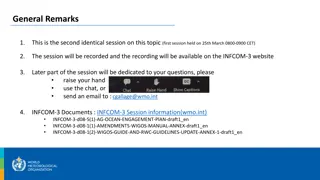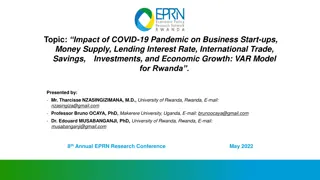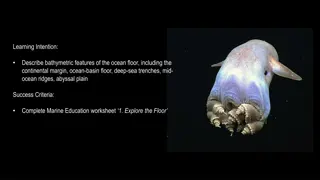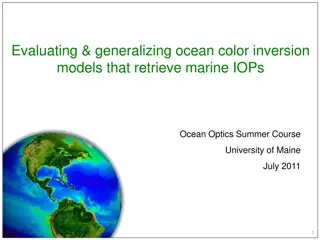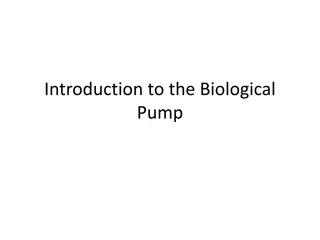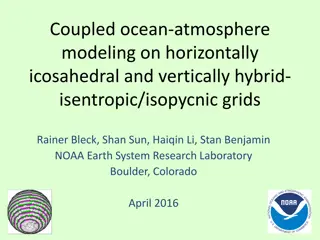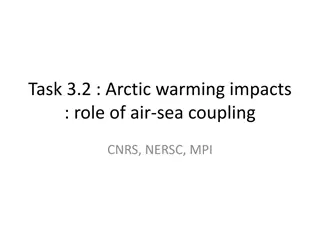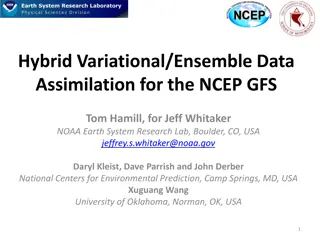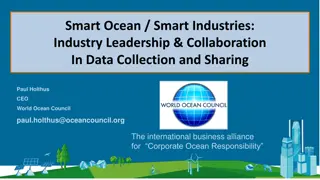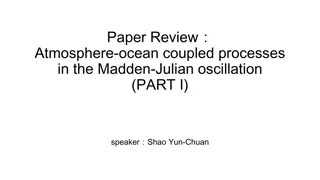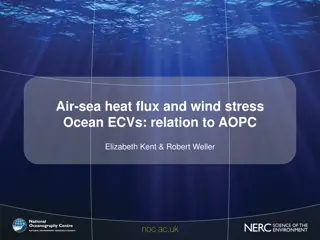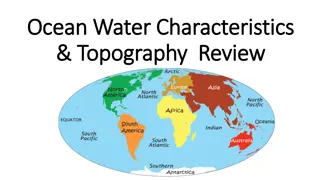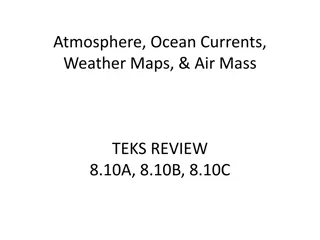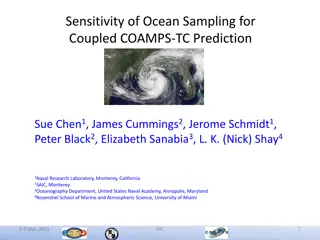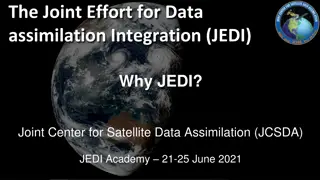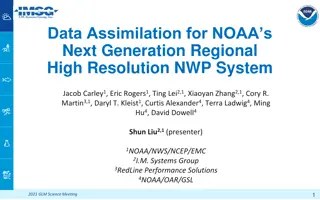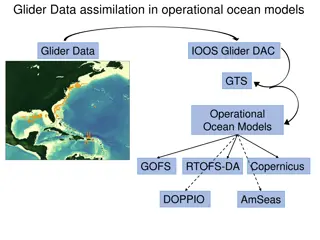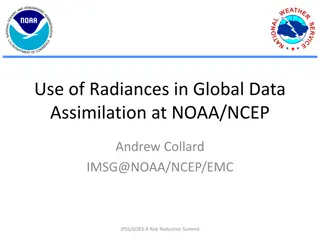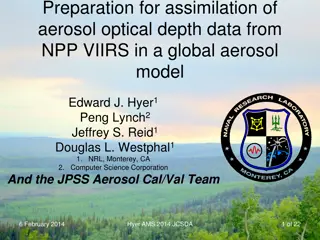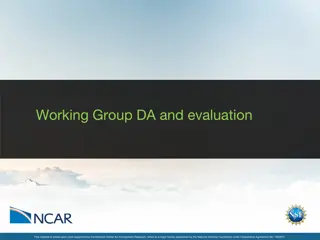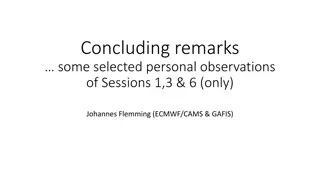Strategies for Coupled 4D-Var Data Assimilation in an Idealised Atmosphere-Ocean Model
This study delves into the exploration of strategies for coupled 4D-Var data assimilation using an idealised atmosphere-ocean model. It discusses the challenges, benefits, and methods involved in transitioning towards coupled data assimilation systems, particularly focusing on the imbalance at the initial time and the transfer of information across the air-sea interface.
Download Presentation

Please find below an Image/Link to download the presentation.
The content on the website is provided AS IS for your information and personal use only. It may not be sold, licensed, or shared on other websites without obtaining consent from the author. Download presentation by click this link. If you encounter any issues during the download, it is possible that the publisher has removed the file from their server.
E N D
Presentation Transcript
Exploring strategies for coupled 4D-Var data assimilation using an idealised atmosphere-ocean model Polly Smith, Alison Fowler & Amos Lawless School of Mathematical and Physical Sciences, University of Reading, UK.
Introduction (1) Typically, initial conditions for coupled atmosphere-ocean model forecasts are provided by combining analyses from independent (uncoupled) data assimilation systems. ignores interactions between systems near surface data not fully utilised, e.g. SST, scatterometer winds Operational centres want to move to coupled data assimilation systems strongly coupled assimilation is technically and scientifically challenging weakly coupled assimilation systems being developed as a first step
Introduction (2) We have been using an idealised 1D coupled atmosphere-ocean model framework to assess the expected benefits of moving towards coupled data assimilation in the context of incremental 4D-Var avoids many of the issues associated with more complex models easier interpretation of results guide the design and implementation of coupled methods within full 3D operational scale systems This talk will focus on imbalance at initial time (initialisation shock) transfer of information across the air-sea interface
Incremental 4D-Var Solve iteratively set outer loop: for k = 0, , Nouter compute inner loop: minimise subject to update
Uncoupled incremental 4D-Var allows for different assimilation window lengths and schemes in atmosphere and ocean avoids new technical development atmosphere obs cannot influence ocean analysis & vice versa atmosphere and ocean analysis dynamically inconsistent - can lead to imbalance in forecast
Strongly coupled incremental 4D-Var coupled model used in both outer and inner loops allows for cross-covariances between atmosphere and ocean BA BOA BAO BO B= better use of near surface observations - atmosphere obs can influence ocean analysis & vice versa requires same window length in atmosphere and ocean Single minimisation process
Weakly coupled incremental 4D-Var coupled model used in outer loop separate inner loop cost functions no explicit cross-covariances between atmosphere and ocean atmosphere (ocean) observations can only influence ocean (atmosphere) analysis if multiple outer loops used limits amount of new technical development allows for different assimilation window lengths and schemes in ocean and atmosphere
Idealised system Atmosphere Simplified version of the ECMWF single column model based on early version of the IFS code adiabatic component + vertical diffusion 4 state variables on 60 model levels forced by large scale horizontal advection Ocean Single column K-Profile Parameterisation (KPP) mixed-layer model based on the scheme of Large et al1 developed by the NCAS climate group at UoR 4 state variables on 35 model levels forced by short and long wave radiation at surface coupled via SST and surface fluxes of heat, moisture & momentum 1. DOI: 10.1029/94RG01872
Identical twin experiments comparison of uncoupled, weakly coupled and fully coupled systems 12 hour assimilation window, 3 outer loops data from June 2013, for point in N Pacific Ocean 'true' initial state is coupled model forecast initialised using ERA Interim and Mercator Ocean data initial background state is a perturbed coupled model forecast observations are generated by adding random noise to 'truth' uncoupled assimilations - SST & surface fluxes from ERA interim error covariance matrices B and R are diagonal simple preconditioning of cost function using B1/2
Initialisation shock truth background IC from strongly coupled IC from weakly coupled IC from uncoupled coupled forecast initialised from t0 analyses SST (K)
Initialisation shock truth background IC from strongly coupled IC from weakly coupled IC from uncoupled coupled forecast initialised from t0 analyses SST (K)
Initialisation shock truth IC from strongly coupled IC from weakly coupled IC from uncoupled atmosphere-ocean temperature difference
Single observation experiments Observing ocean surface current at end of assimilation window strongly coupled weakly coupled analysis increments at t = 0
Double observation experiment atmosphere temperature (K) analysis increments at t=0 atmosphere ob only ocean ob only atmosphere & ocean obs
Summary demonstrated some of the potential benefits expected from coupled data assimilation systems. when compared to uncoupled initialisation, coupled assimilation is able to reduce initialisation shock and its impact on the subsequent forecast - although it may not eliminate it completely. weakly coupled system is sensitive to input parameters of the assimilation but still offers benefits over uncoupled system. single observation experiments demonstrate how coupled assimilation systems enable improved use of near-surface data by transferring information across the air-sea interface. greater transfer of information in weakly-coupled assimilation if both systems are observed.
Future work better understanding the nature and structure of the atmosphere-ocean error cross-covariances and how they should be represented in both strongly and weakly coupled systems Paper to appear in Tellus A soon, pre-print available at www.reading.ac.uk/maths-and-stats/research/maths-preprints.aspx or email p.j.smith@reading.ac.uk
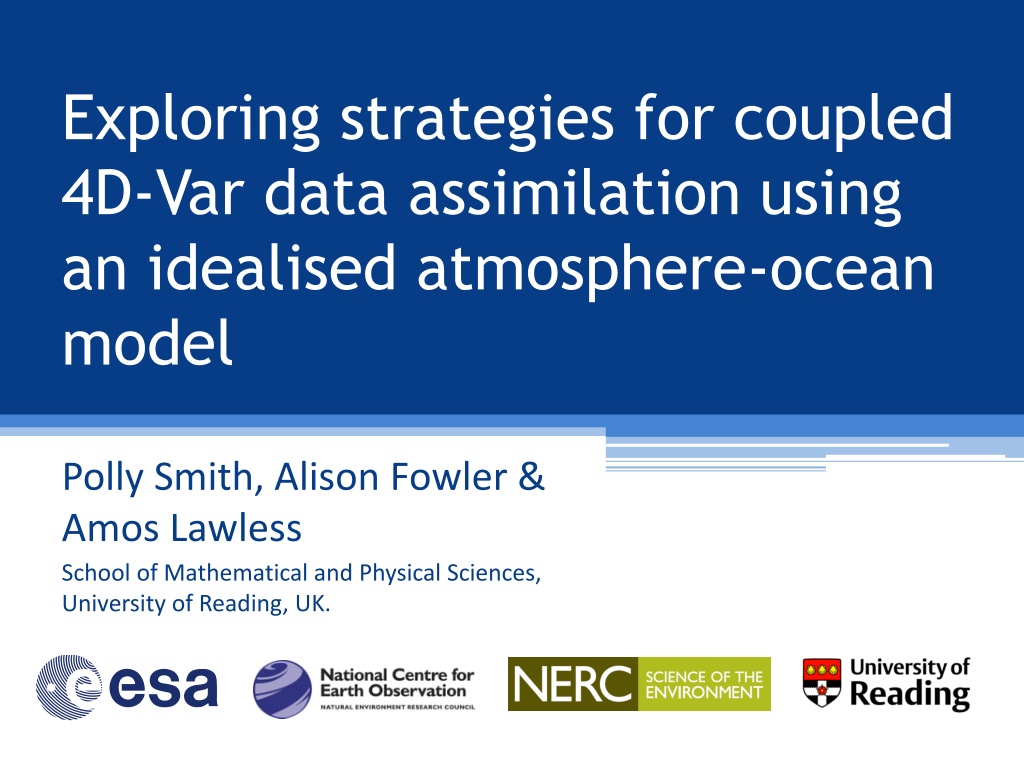
 undefined
undefined












